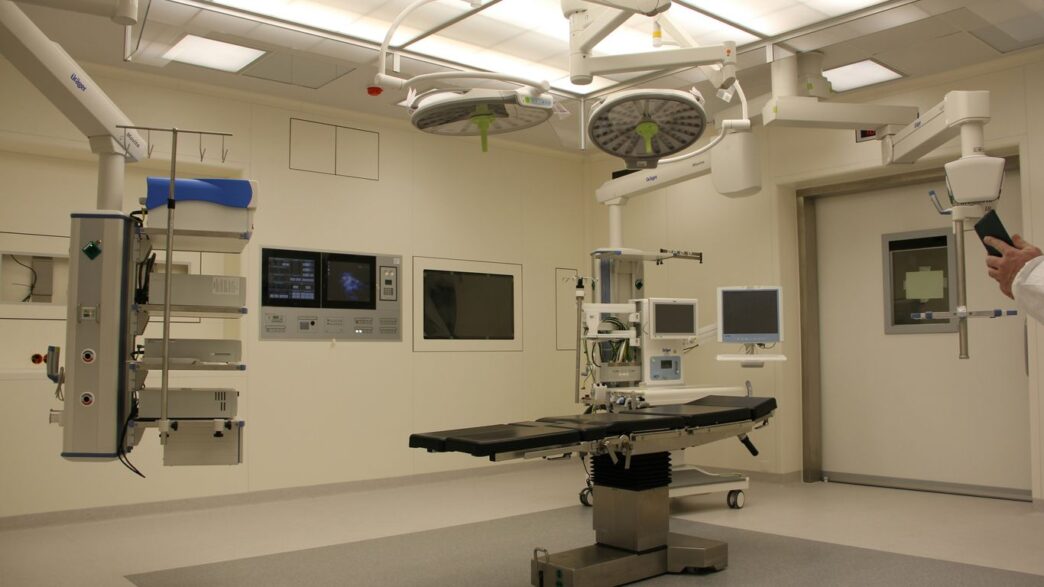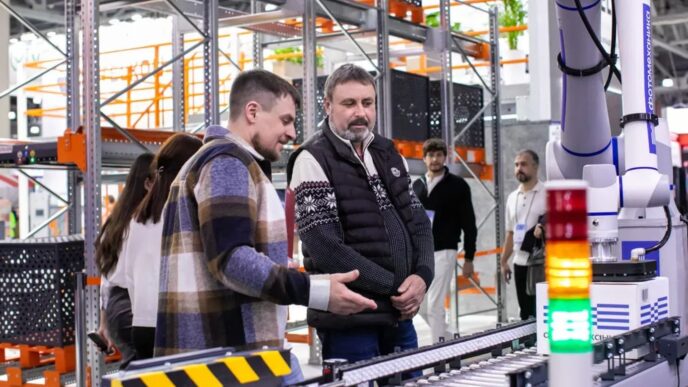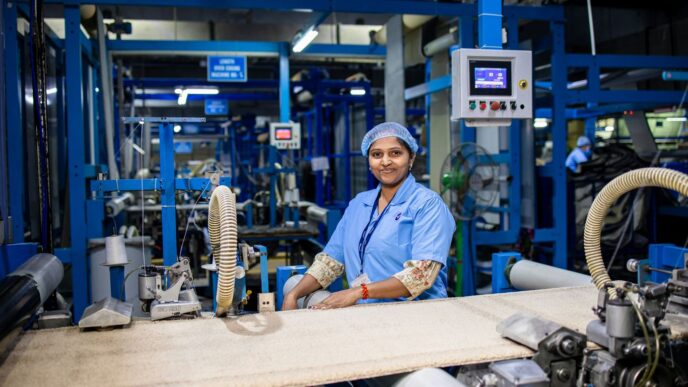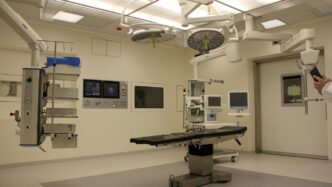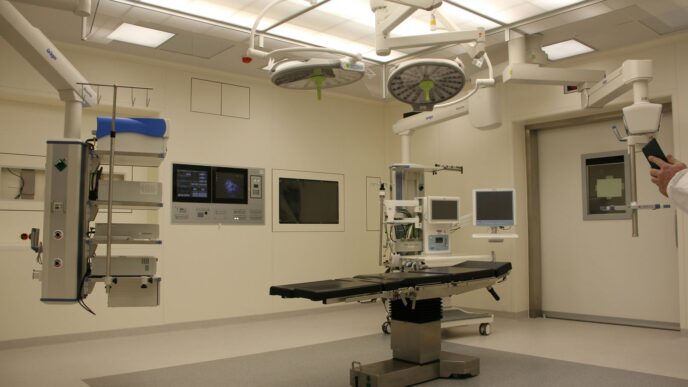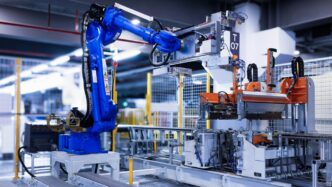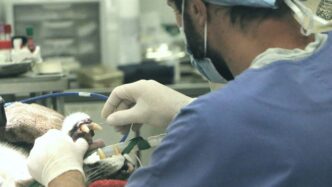Robotic surgery has really changed the game in medicine, and there’s a new player on the block called the Hugo surgical robot system. It’s pretty interesting to see how this technology is developing and what it can do. We’ll take a look at what makes the Hugo system stand out and how it stacks up against what’s already out there. It’s all about making procedures better and safer for patients, and this robot seems to be aiming for just that.
Key Takeaways
- The Hugo surgical robot system offers a modular design with an open console, promoting better team communication during procedures.
- Early studies suggest the Hugo surgical robot is safe and feasible, with complication rates comparable to existing robotic systems.
- While initial setup and operative times might be longer with the Hugo surgical robot, experience leads to improvements and faster console times.
- Surgeons and teams can adapt to the Hugo surgical robot, especially those with prior robotic experience, showing a manageable learning curve.
- The Hugo surgical robot system presents a potentially more cost-effective alternative in the growing field of robotic-assisted surgery.
Understanding The Hugo Surgical Robot System
Introduction To Robotic Surgery
The world of surgery has seen some pretty big changes over the years, right? We went from open surgeries to minimally invasive stuff like laparoscopy, and then, bam, robotic surgery showed up. It really kicked things off around the year 2000 with the da Vinci system. This system gave surgeons a whole new level of precision and a better view, making those tricky procedures a bit more manageable. For a long time, da Vinci was pretty much the only game in town because of patents. But now, those patents are up, and that’s opened the door for new players. Medtronic’s Hugo system is one of them, and it’s bringing some fresh ideas to the table. It’s got some neat tech, like AI and advanced imaging, and a few design tweaks that could make a difference.
The Evolution Of Surgical Robotics
Think about how far we’ve come. Back in the day, surgery was all about big cuts. Then came laparoscopy, using small incisions and cameras. It was better, but still had its limits. Robotic surgery, starting with systems like da Vinci, really changed the game. It gave surgeons robotic arms they could control with incredible precision, often from a special console. This meant less shaking, better angles, and a magnified 3D view. It’s been a huge step forward, especially for complex operations. The expiration of key patents has really shaken things up, allowing companies like Medtronic to step in with their own designs. They’re looking at what worked and what could be improved, trying to offer surgeons more options and potentially better outcomes.
Medtronic’s Entry Into The Robotic Market
So, Medtronic decided to jump into the robotic surgery scene with their Hugo system. It’s not just a copycat; they’ve tried to build something different. One of the big talking points is the open console. Unlike the closed-off setup of some other systems, the Hugo console is designed to let the surgeon see and interact more easily with the rest of the operating room team. This could really help with communication during a procedure. They’ve also gone with a modular design for the robot’s arms. Instead of one big unit, it’s made up of separate carts that can be moved around. This flexibility might make it easier to set up for different types of surgeries and in different operating rooms. It’s Medtronic’s big move to compete in a market that’s been dominated by one company for a while.
Key Features Of The Hugo Surgical Robot
Modular Arm Cart Design
The Hugo system shakes things up with its modular patient arm carts. Unlike some other systems where everything is kind of fixed, Hugo lets you arrange the arms as needed for the specific surgery. This means you can get the best angle and reach for whatever you’re doing, which is pretty neat. It’s designed to be flexible, so it can handle a bunch of different procedures without needing a whole new setup. This adaptability is a big deal for making robotic surgery work in more operating rooms.
Open Console For Enhanced Communication
One of the standout things about Hugo is its open console. Most robotic systems have a closed console where the surgeon is kind of isolated. Hugo’s design is different. It allows the surgeon to see and interact more easily with the rest of the surgical team in the room. This can make communication flow better, which is important when you’re in the middle of a complex operation. It feels more like a team effort, which is how surgery should be.
Advanced Imaging Capabilities
Getting a clear picture during surgery is super important, right? The Hugo system comes with advanced imaging features. This helps the surgical team see what they’re doing with more detail. It’s not just about seeing, but seeing the right things clearly. This can help with precision and making sure everything is done correctly. The system aims to give surgeons the best possible view, which is a big plus for patient safety and outcomes.
Safety And Feasibility Of The Hugo Surgical Robot
When a new piece of medical tech comes out, especially something as complex as a robotic surgery system, people want to know if it’s safe and if it actually works as well as the older stuff. For the Hugo system, this means looking closely at how often things go wrong and if surgeons are getting clean results, like making sure all the cancer is removed. It’s a big deal because you don’t want patients to end up worse off just because they’re trying something new.
Comparing Complication Rates
So, how does Hugo stack up when it comes to complications? Early studies suggest it’s doing pretty well. While complications can happen with any surgery, whether robotic or not, the key is whether the Hugo system itself is causing problems. Most reports show that complication rates are similar to what we see with established systems like the da Vinci. When issues do pop up, they’re often related to the procedure itself, like how a wound is closed, rather than a failure of the robot. It’s also important to track if surgeries need to be switched to a different method, like going back to traditional laparoscopy or open surgery. So far, there haven’t been many reports of that happening with Hugo.
Surgical Margin Analysis
Another really important point is surgical margins – basically, making sure all the diseased tissue is gone. For cancer surgeries, this is non-negotiable. Studies are looking at whether the Hugo system helps surgeons achieve clear margins just as effectively as other robotic platforms. While some early data might show slightly higher rates of positive margins in a few cases, it’s not a statistically significant difference across the board. Many studies report comparable results, meaning the Hugo system appears to be just as capable of precise tissue removal.
Patient Demographics And Case Complexity
To really know if a new system is safe and works well, you need to test it on a good mix of patients. Initially, surgeons might stick to simpler cases while they get used to Hugo. But as they get more comfortable, it’s important that the system can handle a range of patient types and complexities, similar to what’s done with existing robots. Reports indicate that Hugo is being used in patients with varying body mass indexes and even those with more advanced cancer stages. This suggests the system isn’t limited to just straightforward cases and can be applied to a broader patient population, making the comparisons to older systems more meaningful.
The initial phase of adopting any new surgical technology involves careful case selection. As proficiency grows, the scope of applicable patient profiles and procedural complexities should expand to mirror established platforms, thereby validating the new system’s versatility and safety across a wider clinical spectrum.
Transfer Of Skills And Learning Curves
Moving to a new surgical robot system like Hugo means surgeons and their teams have to learn new tricks. It’s not just about the robot itself, but how the whole team works together with it. Think of it like switching from driving a manual car to an automatic – mostly the same goal, but the controls and feel are different.
Surgeon And Team Adaptation
When a hospital brings in the Hugo system, Medtronic usually provides training. This is a big help, especially for the dry runs and practice sessions in the lab before real patients are involved. The team needs to get used to things like the pistol-grip instruments and the way the robot arms move. It takes a bit of time to get comfortable with these new designs.
- Getting a feel for the controls: The way you hold and move the instruments is different from other systems. It takes practice to make these movements feel natural.
- Team coordination: The whole operating room staff needs to understand how the Hugo system works and how to communicate effectively during surgery.
- Setting up the robot: Docking the modular arms to the patient table can be a new step for the team to master.
Early on, you might find that things take a little longer. This is normal. Surgeons and teams tend to be more careful when they’re using new equipment, and that’s a good thing. It’s all part of getting up to speed.
Impact Of Prior Robotic Experience
Here’s where things get interesting: if a surgeon has already used other robotic systems, they often pick up Hugo much faster. It seems like a lot of the skills learned on older systems transfer over pretty well. Some studies show that surgeons with prior experience can adapt to Hugo in as few as ten cases. It’s like they already have a mental map of how robotic surgery works, and they’re just learning the specific routes for Hugo.
Training And Skill Development
For those new to robotic surgery altogether, the learning curve might be a bit steeper. However, the structured training provided is designed to help. The goal is to get everyone proficient and comfortable. As teams gain more experience with Hugo, the time it takes to set up and complete procedures generally decreases. This improvement over time is a clear sign of the learning curve in action.
| Aspect of Learning Curve | Observation |
|---|---|
| Initial Setup Time | Tends to be longer at first due to unfamiliarity with modular arm docking. |
| Console Time | May be longer initially but can become faster than previous systems with practice. |
| Skill Transfer | High for surgeons with prior robotic experience; moderate for robot-naïve surgeons. |
| Team Adaptation | Requires dedicated training and practice for optimal workflow. |
Operative Timings With The Hugo Surgical Robot
Docking And Setup Durations
Getting the Hugo system ready for surgery involves docking the individual arm carts. This modular design offers flexibility, letting surgical teams arrange the arms just right for different procedures. However, this setup can take a bit longer, especially at first. Early studies showed docking times could be around 15 minutes, but with practice, this dropped to about 7 minutes. Compared to older systems, the initial docking might still be a bit lengthier, sometimes taking around 20 minutes versus the older system’s 12.5 minutes. It’s a trade-off for that extra adaptability.
Total Operative Time Comparisons
When we look at the whole surgery time, things get interesting. Some studies suggest that the total time spent in the operating room with Hugo might be a little longer than with established systems, especially in the beginning. This can be due to a few things, like the team getting used to the new equipment or the complexity of the patient’s case. However, other research shows that total operative times are actually quite comparable, with no major differences. It seems like the learning curve plays a big role here; as teams gain more experience, these times tend to even out.
Factors Influencing Procedure Length
Several things can affect how long a surgery takes with the Hugo system. The team’s familiarity with robotic surgery in general, and specifically with Hugo, is a major factor. If the surgeons and nurses have used robotic systems before, they often adapt more quickly. The type of surgery being performed also matters – simpler procedures will naturally take less time. Even the specific setup of the arm carts for a particular operation can add or subtract minutes. Ultimately, experience and standardization of setup are key to optimizing procedure length.
Early on, longer operative times are not necessarily a sign of the system’s inefficiency. It often reflects the meticulous care and attention given to a new technology, as well as the process of adapting to its unique features. As familiarity grows, these timings tend to normalize.
Functional Outcomes And Patient Benefits
When we talk about robotic surgery, especially for procedures like prostatectomies, the big questions often come down to how well patients recover and what their quality of life looks like afterward. It’s not just about getting the surgery done; it’s about the long-term results for the person going through it. The Hugo™ system is being looked at closely to see how it stacks up in these areas.
Urinary Continence Recovery
One of the most significant concerns after prostate surgery is the return of urinary continence. Early data from studies using the Hugo™ system suggests that recovery in this area is generally good. While it can take time, many patients report acceptable levels of continence within the first few months post-operation. Some studies show results that are comparable to what’s seen with other robotic systems, though a few have noted slight differences. It’s a complex area, and individual recovery can vary quite a bit.
Erectile Function Preservation
Another major aspect of patient well-being after prostate surgery is the preservation of erectile function. This is understandably a sensitive topic for many patients. Research is ongoing, but initial findings using specific scoring systems, like the IIEF-5, indicate that the Hugo™ system is performing comparably to established platforms in maintaining erectile function. This is encouraging news, as it suggests the system’s precision might help protect the delicate nerves involved.
Long-Term Patient Well-Being
Beyond the immediate functional recovery, we also need to consider the overall, long-term well-being of patients. This includes everything from their physical recovery and return to daily activities to their psychological state. While it’s still early days for the Hugo™ system, the trend seems positive. The goal is always to provide a surgical option that not only treats the disease effectively but also minimizes the impact on a patient’s quality of life. As more long-term data becomes available, we’ll get a clearer picture of how the Hugo™ system contributes to this overall goal.
The Future Of The Hugo Surgical Robot
So, what’s next for the Hugo system? It’s still pretty new, right? Medtronic is definitely not sitting still. They’re constantly tweaking and improving it based on what surgeons are actually using it for. Think of it like software updates, but for a giant robot that cuts people.
Ongoing System Refinements
One of the big things happening is that Medtronic is really listening to feedback. Remember those little glitches or alarm issues people were talking about? They’ve already rolled out software updates to fix some of that. It’s a good sign that they’re serious about making the system better and easier to use. They’re working on things like:
- Improving the alarm system so it’s more helpful and less annoying.
- Making sure the robot arms don’t bump into each other (that’s a big one!).
- Adding new features that surgeons are asking for.
The system is evolving, and that’s a positive sign for its long-term viability. It shows a commitment to addressing real-world challenges encountered in the operating room.
Expanding Clinical Applications
Right now, Hugo is mostly being used for prostate surgeries, but that’s just the beginning. Medtronic wants to see it used for a lot more types of operations. They’re looking into how it can be used in:
- Gynecological procedures
- General surgery
- Urological surgeries beyond prostatectomy
This means more surgeons will get a chance to try it out and see if it fits their practice. The more it’s used, the more we’ll learn about its full potential.
Cost-Effectiveness And Accessibility
Let’s be real, these robots are expensive. But early reports suggest that Hugo might be a bit more budget-friendly than some of the older systems out there. One analysis even showed it could save about 11% in total costs. This could make robotic surgery available to more hospitals that couldn’t afford it before. If more hospitals can get their hands on it, that means more patients could potentially benefit from minimally invasive robotic procedures. It’s all about making this advanced technology more accessible.
Wrapping Up Our Look at the Hugo Surgical Robot
So, what’s the final word on the Hugo surgical robot system? Based on what we’ve seen, it looks like a solid contender in the world of robotic surgery. It seems to be performing well, with outcomes that are pretty much in line with what surgeons are used to with other systems like da Vinci. While it’s still relatively new, and there’s always more to learn, the early signs are encouraging. The system offers some interesting features, like its modular design, which could be a big plus for different types of surgeries and patient needs. As more surgeons get hands-on experience and more studies come out, we’ll get an even clearer picture. But for now, Hugo appears to be a safe and capable option that’s helping to move surgical technology forward.


